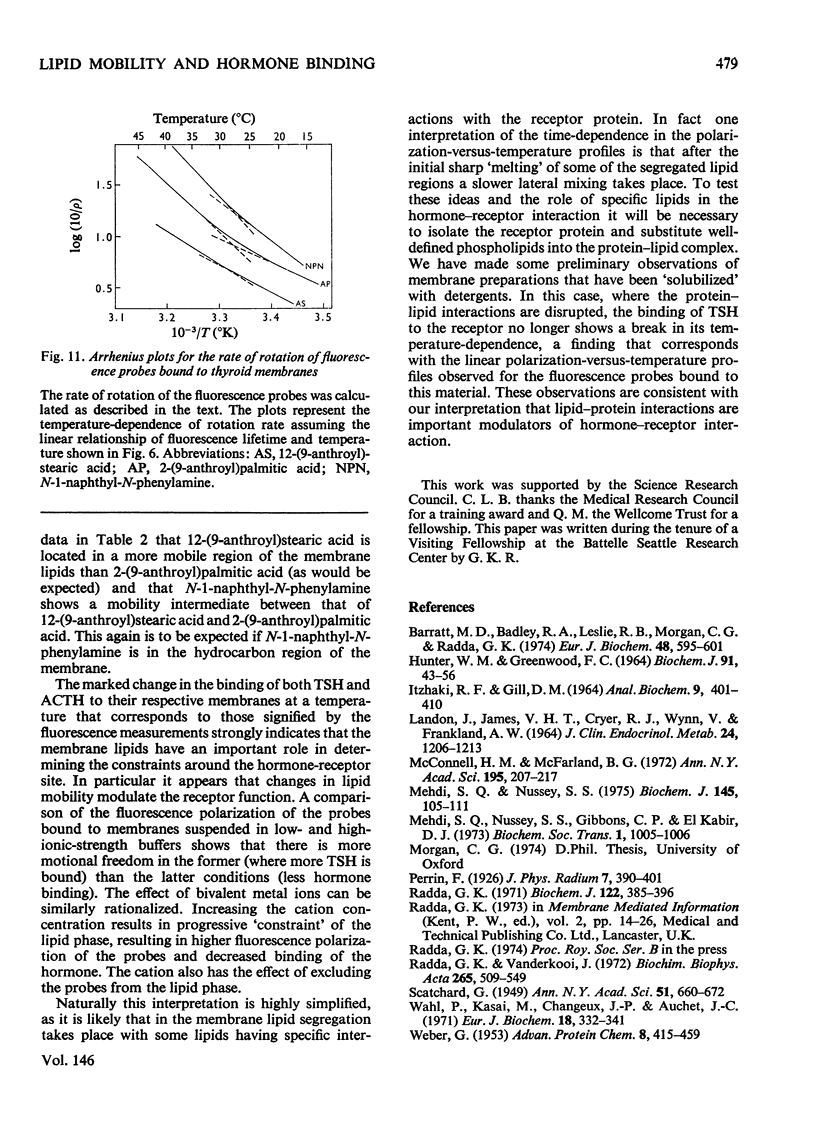Abstract
1. The specific binding of thyroid-stimulating hormone to isolated human thyroid membranes was examined under a variety of conditions. 2. In phosphate-saline buffer (in the presence of 0.14 M-NaCl) on increasing the temperature the binding of the hormone is increased, the plots of bound/free hormone against temperature showing a distinct break around 30 degrees C. 3. Detailed analysis showed that the increased binding is associated with an increase in the number of binding sites. 4. The motional characteristics of three membrane-bound fluorescent probes, 2-(9-anthroyl)palmitic acid, 12-(9-anthryl)stearic acid and N-1-naphthyl-N-phenylamine, were also examined as a function of temperature by measuring both fluorescence polarizations and lifetimes. 5. The results indicated that the 'fluidity' of membrane lipids also increased with temperature. The temperature-dependence of this property also shows a change at about 30 degrees C. 6. Bivalent cations decreased both membrane fluidity and hormone binding. 7. Similar correlations were found between the binding of adrenocorticotrophic hormone and the fluidity of the plasma membranes obtained from adrenal-cortical cells, with the discontinuity occurring in this case at 23 degrees C. 8. The possibility of lipid mobility being important in controlling hormone-receptor function is discussed.
Full text
PDF






Selected References
These references are in PubMed. This may not be the complete list of references from this article.
- Barratt M. D., Badley R. A., Leslie R. B. The interaction of apoprotein from porcine high-density lipoprotein with dimyristoyl phosphatidylcholine. Electron spin resonance and fluorescent probe. studies. Eur J Biochem. 1974 Oct 2;48(2):595–601. doi: 10.1111/j.1432-1033.1974.tb03802.x. [DOI] [PubMed] [Google Scholar]
- Hunter W. M., Greenwood F. C. A radio-immunoelectrophoretic assay for human growth hormone. Biochem J. 1964 Apr;91(1):43–56. doi: 10.1042/bj0910043. [DOI] [PMC free article] [PubMed] [Google Scholar]
- ITZHAKI R. F., GILL D. M. A MICRO-BIURET METHOD FOR ESTIMATING PROTEINS. Anal Biochem. 1964 Dec;9:401–410. doi: 10.1016/0003-2697(64)90200-3. [DOI] [PubMed] [Google Scholar]
- LANDON J., JAMES V. H., CRYER R. J., WYNN V., FRANKLAND A. W. ADRENOCORTICOTROPIC EFFECTS OF A SYNTHETIC POLYPEPTIDE--BETA 1-24-CORTICOTROPIN--IN MAN. J Clin Endocrinol Metab. 1964 Nov;24:1206–1213. doi: 10.1210/jcem-24-11-1206. [DOI] [PubMed] [Google Scholar]
- McConnell H. M., McFarland B. G. The flexibility gradient in biological membranes. Ann N Y Acad Sci. 1972 Jun 20;195:207–217. [PubMed] [Google Scholar]
- Mehdi S. Q., Nussey S. S. A radio-ligand receptor assay for the long-acting thyroid stimulator. Inhibition by the long-acting thyroid stimulator of the binding of radioiodinated thyroid-stimulating hormone to human thyroid membranes. Biochem J. 1975 Jan;145(1):105–111. doi: 10.1042/bj1450105. [DOI] [PMC free article] [PubMed] [Google Scholar]
- Radda G. K. Enzyme and membrane conformation in biochemical control. Biochem J. 1971 May;122(4):385–396. doi: 10.1042/bj1220385. [DOI] [PMC free article] [PubMed] [Google Scholar]
- WEBER G. Rotational Brownian motion and polarization of the fluorescence of solutions. Adv Protein Chem. 1953;8:415–459. doi: 10.1016/s0065-3233(08)60096-0. [DOI] [PubMed] [Google Scholar]
- Wahl P., Kasai M., Changeux P. A study on the motion of proteins in excitable membrane fragments by nanosecond fluorescence polarization spectroscopy. Eur J Biochem. 1971 Feb 1;18(3):332–341. doi: 10.1111/j.1432-1033.1971.tb01248.x. [DOI] [PubMed] [Google Scholar]


